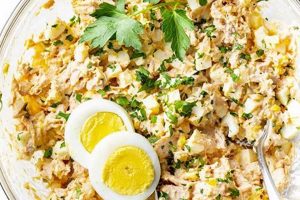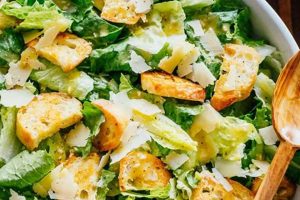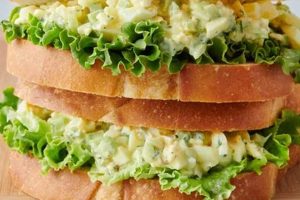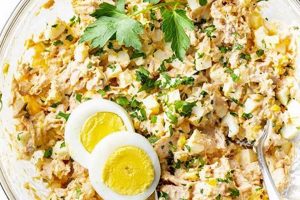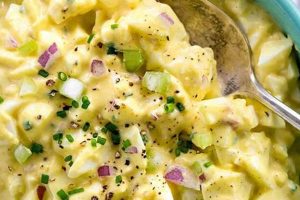A blend of hard-boiled eggs, mayonnaise, and seasonings creates a versatile dish enjoyed in sandwiches, salads, or as a standalone snack. Variations often include mustard, celery, onion, relish, or spices like paprika and dill for added flavor complexity. The quality of ingredients directly impacts the final taste, with fresh, high-quality eggs and mayonnaise recommended for optimal results.
This classic dish offers a good source of protein and essential nutrients. Its adaptability makes it a convenient option for quick meals, picnics, or potlucks. Historically, egg salad emerged as a popular dish with the rise of refrigeration and mayonnaise production in the late 19th and early 20th centuries, evolving from earlier European egg and mayonnaise-based salads. Its affordability and ease of preparation contributed to its widespread adoption in various cultures.
This discussion will explore optimal ingredient selection, techniques for achieving perfect hard-boiled eggs, and creative variations to elevate this culinary staple. Guidance on safe handling and storage practices will also be provided to ensure optimal freshness and food safety.
Tips for an Exceptional Egg Salad
Achieving a superior egg salad involves attention to detail in every step, from ingredient selection to preparation techniques. These tips offer guidance for creating a dish that stands out in flavor and texture.
Tip 1: Egg Quality Matters: Opt for the freshest, highest-quality eggs available. Farm-fresh eggs often yield richer flavor and better texture.
Tip 2: Perfect Hard-Boiled Eggs: Achieving perfectly cooked yolks, neither rubbery nor undercooked, is crucial. A gentle simmer followed by an ice bath prevents overcooking and facilitates easy peeling.
Tip 3: Mayonnaise Selection: The choice of mayonnaise significantly impacts the overall flavor profile. Experiment with different brands or consider making homemade mayonnaise for ultimate control over ingredients.
Tip 4: Seasoning is Key: Beyond basic salt and pepper, consider incorporating Dijon mustard, paprika, dill, or other spices to enhance flavor complexity. Taste and adjust seasonings throughout the preparation process.
Tip 5: Texture Considerations: Dicing eggs uniformly creates a pleasing consistency. Over-mashing can result in a mushy texture. A combination of chopped and lightly mashed yolks can create an appealing contrast.
Tip 6: The Role of Add-ins: Finely chopped celery, red onion, or fresh herbs add textural and flavor dimensions. Consider incorporating chopped pickles, relish, or capers for a tangy twist.
Tip 7: Proper Storage: Refrigerate promptly in an airtight container. Consume within three to five days for optimal freshness and food safety.
By following these tips, one can elevate a simple egg salad to a truly delightful culinary experience. Attention to detail in each step ensures optimal flavor, texture, and presentation.
From classic preparations to innovative variations, the following section will offer diverse recipe ideas to inspire culinary creativity.
1. High-Quality Ingredients
The foundation of a truly delicious egg salad rests upon the quality of its ingredients. Subpar components yield a mediocre result, while fresh, high-quality ingredients elevate the dish to a new level of culinary enjoyment. This section explores the crucial role of ingredient selection in crafting an exceptional egg salad.
- Fresh Eggs:
Eggs form the core of this dish, and their freshness significantly impacts the final flavor. Farm-fresh eggs, if available, offer superior richness and a noticeably smoother texture compared to older, store-bought alternatives. The difference in taste is substantial, influencing both the egg itself and its interaction with other ingredients.
- Mayonnaise:
Mayonnaise binds the salad together and contributes significantly to its overall flavor profile. High-quality mayonnaise, whether store-bought or homemade, offers a richer, creamier texture and a more balanced flavor compared to generic brands. Choosing a mayonnaise made with quality oils and without excessive additives enhances the overall taste experience.
- Fresh Produce:
Additions like celery, onions, and herbs introduce textural and flavor complexity. Fresh, crisp produce offers optimal crunch and flavor. Wilted or older vegetables detract from both the aesthetic appeal and the overall enjoyment. Using vibrant, recently harvested produce ensures the brightest flavors and textures.
- Seasonings and Spices:
Even seemingly minor ingredients like mustard, paprika, or dill play a crucial role in shaping the final flavor profile. High-quality spices offer more pronounced and nuanced flavors, allowing for greater control over the overall taste. Freshly ground spices, whenever possible, further enhance the sensory experience.
Investing in high-quality ingredients for egg salad yields a significantly more satisfying culinary experience. The interplay of fresh eggs, premium mayonnaise, vibrant produce, and nuanced spices creates a symphony of flavors and textures that elevates this simple dish to a truly delightful culinary creation. Discerning palates will appreciate the noticeable difference between an egg salad crafted with superior ingredients and one made with subpar components.
2. Proper Egg Cooking
Proper egg cooking forms the cornerstone of a delicious egg salad recipe. The texture of the cooked egg significantly influences the final product’s overall palatability and aesthetic appeal. Overcooked eggs become rubbery and dry, while undercooked eggs create a watery, unappetizing consistency. This section explores the nuances of proper egg cooking techniques and their direct impact on egg salad quality.
- Timing and Temperature Control:
Precise timing and temperature control are crucial for achieving the perfect hard-boiled egg. A gentle simmer, rather than a rolling boil, ensures even cooking and prevents the formation of a green ring around the yolk. Maintaining a consistent temperature throughout the cooking process contributes to a tender, evenly cooked yolk, essential for a creamy and flavorful egg salad.
- The Ice Bath:
Immediately plunging cooked eggs into an ice bath halts the cooking process and facilitates easier peeling. The rapid temperature change helps separate the egg white from the shell, minimizing the chances of tearing or damage during peeling. This results in smoother, more aesthetically pleasing egg slices for the salad.
- Freshness of Eggs:
While not directly related to the cooking process, the freshness of the eggs impacts how easily they peel. Fresher eggs tend to adhere more strongly to the shell, making peeling more challenging. Slightly older eggs, while still perfectly safe to consume, often peel more easily, simplifying the preparation process and contributing to a more visually appealing final product.
- Method of Cooking:
Various methods exist for cooking eggs, including steaming and baking. While boiling remains the most common approach for egg salad, alternative methods can yield slightly different textures. Experimentation with different cooking techniques may reveal subtle nuances in flavor and texture that align with individual preferences.
Mastering the art of properly cooking eggs is fundamental to achieving a delicious egg salad. Attention to detail in timing, temperature, and the cooling process ensures optimal texture and ease of preparation. These factors contribute significantly to the overall enjoyment and aesthetic appeal of the final dish. A perfectly cooked egg, neither rubbery nor undercooked, provides the ideal foundation for a flavorful and visually appealing egg salad.
3. Balanced Seasoning
Balanced seasoning is paramount in crafting a delicious egg salad. It elevates the dish beyond simple sustenance, transforming it into a flavorful and enjoyable culinary experience. The interplay of salt, pepper, and other spices enhances the inherent flavors of the eggs and other ingredients, creating a harmonious blend that tantalizes the taste buds. An overabundance of any single seasoning can overwhelm the delicate balance, while insufficient seasoning results in a bland and uninspiring dish. The objective is to achieve a symphony of flavors where each component complements and enhances the others.
Consider the role of salt. It amplifies the natural sweetness of the eggs and other ingredients, such as onions or celery. However, excessive salt masks these subtle nuances, leaving a harsh, salty taste. Similarly, black pepper adds a subtle warmth and complexity, but too much can create an overpowering bitterness. The judicious use of acid, such as a touch of lemon juice or vinegar, brightens the flavors and adds a refreshing tang. Incorporating herbs and spices, like dill, paprika, or mustard powder, introduces further complexity and depth. A classic combination of Dijon mustard and paprika offers a balanced blend of tanginess and subtle smokiness.
Achieving balanced seasoning requires careful consideration and, often, experimentation. Start with a small amount of each seasoning and taste frequently, adjusting as needed. The specific ratios will vary depending on individual preferences and the other ingredients in the egg salad. A discerning palate recognizes the delicate balance between the various components and adjusts accordingly. Mastering this aspect of egg salad preparation transforms a simple dish into a culinary delight, demonstrating an understanding of flavor dynamics and the transformative power of balanced seasoning.
4. Textural Contrast
Textural contrast significantly contributes to a delicious egg salad recipe. A monotonous texture, whether overly smooth or excessively chunky, diminishes the eating experience. A dynamic interplay of textures, however, elevates the dish, creating a more engaging and satisfying culinary experience. This contrast stimulates the palate, offering a more complex and enjoyable sensory perception.
Consider the primary components of egg salad: eggs and mayonnaise. Over-mashing the eggs results in a paste-like consistency that lacks textural interest. Conversely, coarsely chopping the eggs, while providing some texture, can feel unwieldy and disconnected. A combination of finely chopped whites and lightly mashed yolks offers a more appealing balance, providing both a creamy base and distinct textural elements. This contrast prevents the salad from becoming monotonous, creating a more dynamic and enjoyable mouthfeel.
Further textural complexity can be achieved through the incorporation of additional ingredients. Finely diced celery or red onion introduces a crisp, contrasting element against the creamy egg mixture. Chopped pickles or water chestnuts offer a different type of crunch, while the addition of toasted nuts or seeds provides a welcome textural variation and a subtle nutty flavor. The interplay of these different texturescreamy, crunchy, and potentially even a bit chewycreates a multi-dimensional sensory experience that elevates the egg salad from simple to sophisticated.
Understanding the importance of textural contrast in egg salad allows for informed ingredient selection and preparation techniques. Careful consideration of how different ingredients contribute to the overall textural profile enables the creation of a more balanced and satisfying dish. This attention to detail elevates the egg salad experience, transforming it from a basic meal into a culinary delight. It demonstrates a sophisticated understanding of the crucial role texture plays in creating a truly delicious and memorable dish.
5. Creative Additions
Creative additions distinguish a standard egg salad from a truly exceptional one. These additions introduce complexity and depth, transforming a simple dish into a culinary experience. They provide opportunities to personalize the recipe, catering to individual preferences and exploring diverse flavor profiles. The thoughtful incorporation of creative additions demonstrates culinary expertise and a willingness to experiment beyond the conventional.
Fresh herbs offer a vibrant and aromatic dimension. Dill, parsley, chives, or tarragon impart distinct flavors that complement the richness of the eggs and mayonnaise. Incorporating spices such as curry powder, smoked paprika, or a pinch of cayenne pepper introduces warmth and complexity. Textural elements like chopped nuts, toasted seeds, or crumbled bacon provide contrasting textures and savory notes. The addition of chopped vegetables extends beyond the traditional celery and onion, incorporating ingredients like bell peppers, water chestnuts, or chopped artichoke hearts for added flavor and textural nuance.
For example, incorporating chopped capers and a squeeze of lemon juice evokes a bright, briny flavor reminiscent of a classic Nioise salad. Alternatively, adding diced avocado and a sprinkle of chili flakes creates a creamy, subtly spicy variation. These additions not only enhance the flavor profile but also offer nutritional benefits, introducing healthy fats, vitamins, and antioxidants. The creative possibilities are vast, limited only by culinary imagination and a willingness to explore unconventional combinations.
The considered inclusion of creative additions demonstrates an understanding of flavor balance and texture interplay. It showcases an ability to move beyond traditional recipes, experimenting with ingredients and techniques to create something unique and memorable. Such additions elevate egg salad from a simple staple to a dish worthy of culinary recognition, reflecting a dedication to creating a truly delicious and satisfying dining experience.
Frequently Asked Questions
This section addresses common inquiries regarding optimal preparation and enjoyment of egg salad.
Question 1: How long can egg salad be safely stored?
Refrigerated egg salad, stored in an airtight container, typically remains safe for consumption for three to five days. Beyond this timeframe, the risk of bacterial growth increases significantly.
Question 2: What are the signs of spoiled egg salad?
Spoiled egg salad often exhibits a sour or unpleasant odor. Changes in texture, such as excessive sliminess or dryness, also indicate spoilage. Discoloration, particularly a greenish tinge, may occur. If any of these signs are present, discarding the egg salad is recommended.
Question 3: Can egg salad be frozen?
Freezing egg salad is generally not recommended. The mayonnaise-based dressing separates and becomes watery upon thawing, resulting in an undesirable texture. The overall quality and flavor of the egg salad are significantly compromised by freezing.
Question 4: How can one achieve perfectly hard-boiled eggs for egg salad?
A gentle simmer, followed by an immediate ice bath, yields perfectly cooked hard-boiled eggs. Overcooking results in rubbery yolks and an unpleasant sulfurous odor. Undercooking leads to a runny yolk and difficulties in chopping or mashing for the salad.
Question 5: What are some healthy variations of egg salad?
Substituting Greek yogurt for a portion of the mayonnaise reduces fat content while maintaining creaminess. Incorporating additional vegetables, such as chopped bell peppers or spinach, increases nutritional value. Using whole-grain bread or crackers for serving provides added fiber.
Question 6: How can one prevent egg salad from becoming watery?
Ensuring eggs are thoroughly cooled before chopping and using a minimal amount of mayonnaise helps prevent excess moisture. Adding a small amount of finely diced celery or onion can absorb excess liquid. Draining any excess liquid released by the chopped vegetables before incorporating them into the salad also contributes to a firmer consistency.
Proper storage, ingredient selection, and attention to detail in preparation are essential for maximizing the quality and safety of egg salad. Understanding these key elements contributes to a more enjoyable and satisfying culinary experience.
For those seeking culinary inspiration, the following section explores variations and serving suggestions for egg salad.
Delicious Egg Salad Recipe
Exploration of the elements contributing to a delicious egg salad recipe reveals the importance of ingredient quality, precise cooking techniques, balanced seasoning, textural contrast, and creative additions. High-quality eggs and mayonnaise form the foundation. Properly cooked eggs, neither rubbery nor undercooked, ensure optimal texture. Balanced seasoning enhances inherent flavors without overwhelming the palate. A combination of chopped and mashed eggs, complemented by crisp vegetables or crunchy nuts, creates a dynamic textural experience. Thoughtful additions of herbs, spices, or other complementary ingredients elevate the dish beyond the ordinary.
Culinary potential extends beyond basic preparation. This exploration provides a framework for crafting egg salad variations tailored to individual preferences. From classic combinations to innovative interpretations, the possibilities for creating a truly delicious and satisfying egg salad experience are vast. Application of these principles elevates this simple dish to a culinary art form.

